Dinosaurs in Peru
Though they disappeared millions of years ago, the vestiges of their existence are evident today in the form of fossils. These remains are the objects of study for palaeontologists who recognise, clean and classify them like pieces of a puzzle, giving us an idea of how the prehistoric would would have looked like.
Palaeontology is, unfortunately, not a discipline taught in Peruvian universities, so there are only two ways to become a “dinosaur hunter” in Peru; study biology then go abroad to specialise in palaeontology, or self-taught through practice – the route taken by Rodolfo Salas, member of the palaeontology department at the University of San Marcos.
Salas, with a team of French and US colleagues, has proven wrong the myth in palaeontology that the rainforest is not somewhere you would ever find fossils – mostly due to the high humidity and movement of the soils from growing tree roots. In a study in 2005 his team discovered fossils of huge reptiles from the time of the dinosaurs, and giant mammals from periods that followed, around the jungle city of Iquitos. As a result of these studies we are now aware of new species such as the peculiar cocodrilo sebecus, a reptile similar to crocodiles but better suited to walking on land with longer downward pointing legs that allowed it to chase prey. It lived 12 million years ago.
In Peru, there exist two prime locations for those interested in palaeontology; Bagua in the department of Amazonas and in the deserts of the southern region of Ica.
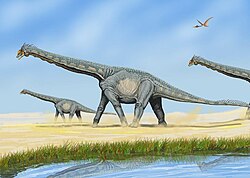 The town of Bagua in the region of Amazonas is one of the richest places in Peruvian palaeontology. It is here that the 67 million year old femur of a Titanosaur was discovered that is now exhibited in the Museum of Natural History in Lima. This herbivore measured an astonishing 14 metres heigh by 5 metres long.
The town of Bagua in the region of Amazonas is one of the richest places in Peruvian palaeontology. It is here that the 67 million year old femur of a Titanosaur was discovered that is now exhibited in the Museum of Natural History in Lima. This herbivore measured an astonishing 14 metres heigh by 5 metres long.
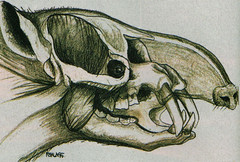 The Miocene epoch stretched from 23 million years ago to 5 million years ago, and was the time of the mammals. It was in these years that camels, horses, big cats and the baguatherium jaureguii appeared. For Salas, this animal of three metres in length is enigmatic. “It had two lower tusks and four upper, a trunk and a stout body. It isn’t related to any of today’s mammals but looks like a cross between a rhino, an elephant and a tapir”.
The Miocene epoch stretched from 23 million years ago to 5 million years ago, and was the time of the mammals. It was in these years that camels, horses, big cats and the baguatherium jaureguii appeared. For Salas, this animal of three metres in length is enigmatic. “It had two lower tusks and four upper, a trunk and a stout body. It isn’t related to any of today’s mammals but looks like a cross between a rhino, an elephant and a tapir”.
Another creature found in Peru is the purussaurus. A huge type of cayman it looks nothing like those you find today it in Amazon – it was a huge creature.
16 million years ago, what we know as the rainforest today was underwater. This sea stretched to the Caribbean with alternating currents of fresh and salt water. French geologist a colleague of Salas, Patrice Baby, tells us that these conditions generated an amazing level of biodiversity. “The quality and variety of fossils we have found here in Amazonas from this period might explain the huge levels of biodiversity we see on the continent today”. The purussaurus is one of the stars of the Miocene epoch. According to its biggest fan, palaeontologist Klaus Hönninger it must have fed on all that got in its way, from giant turtles to large mammals until about 5 million years ago it faded from existence.

The Megalodon: the largest thing to ever roam the oceans. See how it compares to a human here. |
Hönninger, an engineer by profession, was born in Chiclayo but has lived in Germany most of his life. There amateur palaeontology is big, with people going off with picks and shovels looking for their own fossils. It was in this way that Hönninger built up a collection of fossils numbering in the hundreds, among them four dinosaurs. Last year, Hönninger invited German scientists and museum curators to Peru and in an expedition in the desert of Ica they managed to make one of the most important palaeontological discoveries of the century; the dorsal fin of a megalodon of 18 metres. The megalodon, scientific name charcarocles megalodo, was the biggest shark that has ever swam the worlds oceans and makes its relative, the Great White Shark, look like a gold fish.

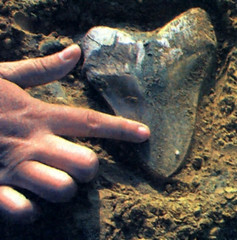
This dig in Ica is special for various reasons. Firstly, it is very difficult for cartilage fossilize, and secondly, this is the first time a dorsal fin of a megalodon, extinct for 30 million years, has ever been found – ever. All that is missing the help and support of Peru’s terrible National Institute of Culture (INC) to raise and legitimise the find that could be the greatest in the history of Peruvian palaeontology.
The Sabre-Tooth Tigre is another species that roamed territory that today is known as Peru, one that went extinct 10 million years ago. Salas explains that, as an animal that weighed as much as 300 kilos, the Sabre-Tooth could not run large distances and so we presume it pounced on its prey, cutting its throat with its 18cm long fangs.
 We know that a dinosaur once wandered, 65 million years ago through Querulpa in Arequipa, because here you can still find its footprints in the ground. Although the dinosaur in question has not yet been identified, we know it came from the abelisauridae family, dinosaurs with powerful hind legs and tiny front legs. The best known member of this family is the Carnotaurus, a fierce carnivore with horns on its head.
We know that a dinosaur once wandered, 65 million years ago through Querulpa in Arequipa, because here you can still find its footprints in the ground. Although the dinosaur in question has not yet been identified, we know it came from the abelisauridae family, dinosaurs with powerful hind legs and tiny front legs. The best known member of this family is the Carnotaurus, a fierce carnivore with horns on its head.
The plesiosaurus is from a time much before the time of the carnotaurus. In 2001, two amateur palaeontologists, Iván Meza and Manuel Rojas found some fossils in the southern Lima district of Chorrillos that, thanks to Salas and some of his Argentine colleagues, were recognised as being the bones of a plesiosaur. “It is the first and only found in Peru”, Meza explains proudly, “I want to report it scientifically in some recognised publication. Only in this way will the scientific community hear of this discovery”.
The dinosaurs didn’t only dominate Peru’s seas and land, they also ruled its skies. 110 million years ago reptiles like the pterosaurus, flew over what is now Peru, proven by the remains found in modern-day Huánuco. It was a carnivore with a wing-span of 7 metres.
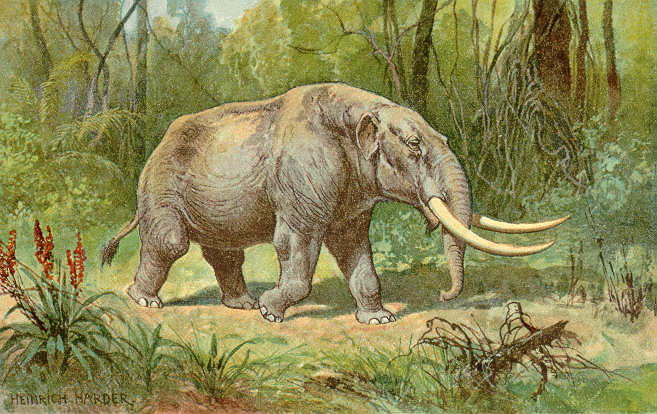 Many years ago, the remains of three of the biggest mammals that have ever populated this country were found. The megaterium was a giant at 7 metres tall – about 3 floors of a building – and very powerful. The biggest found was discovered in Tarapoto and lived 10 million years ago.
Many years ago, the remains of three of the biggest mammals that have ever populated this country were found. The megaterium was a giant at 7 metres tall – about 3 floors of a building – and very powerful. The biggest found was discovered in Tarapoto and lived 10 million years ago.
The mastodon, similar to an elephant, lived in all of what is now Peru. “Its amazing to think that our country looked like Africa 10 million years ago”, says Salas. At the same time lived the giant armadillo, a creature much like today’s variety but as Hönninger explains, “about the size of a Volkswagen beetle”.
Hönninger plans to build a museum in Trujillo to exhibit his collection, but it remains up to authorities like the INC to investigate the cases of destructive digs and illegal trade in fossils, something Salas and Hönninger have both witnessed, including in Ica with the robbery of the megalodon’s teeth. Where palaeotology in Peru goes from here remains to be seen.
Tags: amazonas, bagua, chiclayo, chorrillos, dinosaurs, fossils, ica, iquitos, palaeontology, san marcos, tarapoto, trujillo








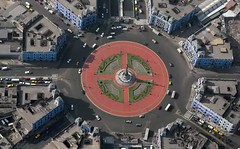

![Loosing weight in Peru [Featured]](http://farm4.static.flickr.com/3263/2894149292_88b26222f4_m.jpg)